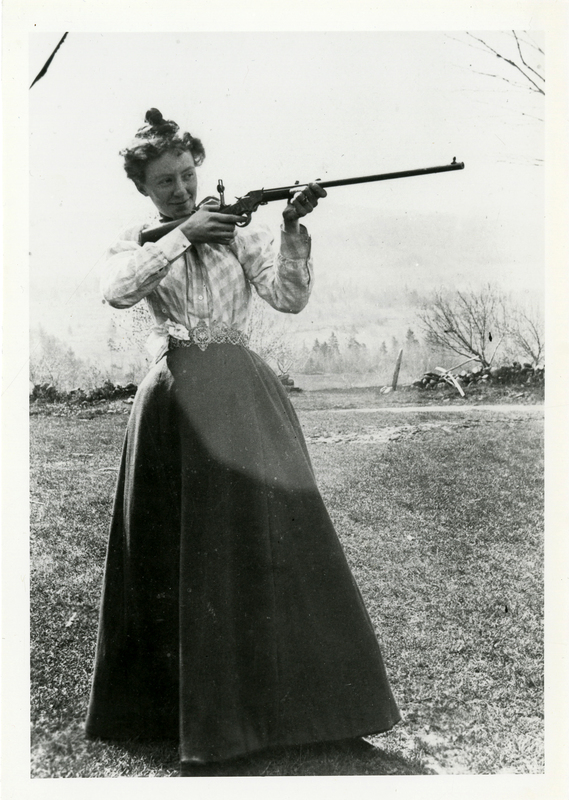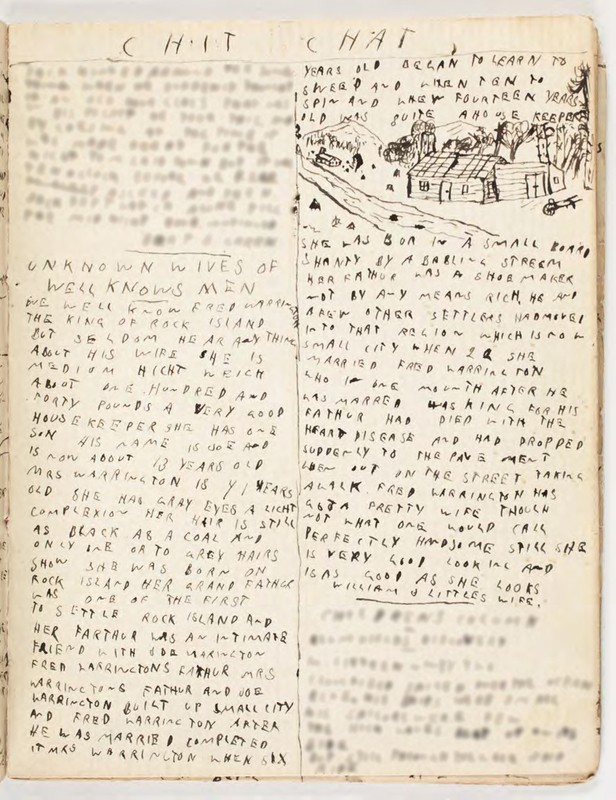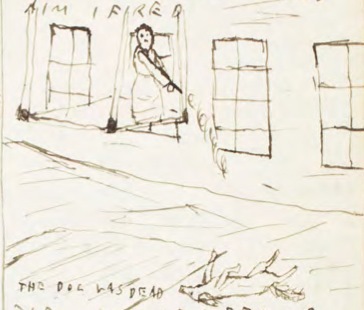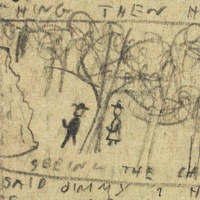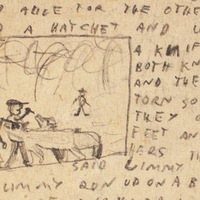Girls
The Nelson brothers were quite progressive for their time. While periodicals like The Youth's Companion (a magazine we know the brothers subscribed to) were publishing articles about the vanity of women, the brothers spotlighted girls as accomplished wives and brave fighters. In the words of one of their female protagonists, "boys need not think they have all the glory and honor of stories for girls are just as smart as boys...." While girls don't appear much in the manuscripts, when they do they are typically given fearless roles. In fact, the girls that appear in the Nelson brother stories are among the few characters across all texts who ever successfully shoot their targets!
As Wives and Lovers:
"Unknown Wives of Well Known Men"
The brothers clearly felt some obligation to give women their fair share of page-time. In a section of the January 12, 1893 issue of Chit-Chat, they created a profile to spotlight women that often go ignored in light of the success of their husbands. The first and only in this series features the wife of Fred Warrington, king of Rock Island.
The brothers meant well, but ironically their profile, after briefly detailing Mrs. Warrington's physical description and housekeeping accomplishments, devotes most of its time to praising her husband, father, and husband's father. The article ends, "Fred Harrington has got a pretty wife though not what one would call perfectly handsome..." Never once do the brothers mention the wife's name, and the article, too, is written by an unnamed woman—William J. Little's wife. Earlier in the same issue the brothers feature poetry signed by Etta Little. Why not use her name here? Though intended to spotlight females, this article is clearly framed within the patriarchy. A valiant attempt Nelsons, but you still have quite a ways to go!
...from The Mountain News Jan 30
(Mother wishing to hurry matters a little)
"I should think Mr Blossom would be tired of making love to you daughter."
"I guess he is he proposed to me last night."
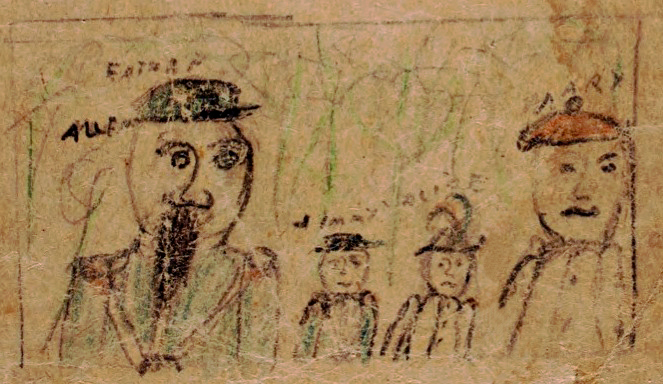
A family portrait graces the cover of "Ethan F Allen and His Family," labeled from left to right: Ethan, Jimmy, Alice, Mary.
As Hunters and Warriors:
In Eathan F. Allen and His Family the title character's daughter, Alice, and wife, Mary, are praised for their bravery at the end of the story, when Eathan Allen, president of Big Continent, returns home from battle and discovers that his homefront had been attacked by his arch nemesis William Little (in real life Eathan Allen and William Little were the alter egos of brothers Walter and Arthur, respectively). Here is the account:
“Alice and Mary were in the house that Long Islander attacked and Mary took her revolver that Eathan Allen gave her then they fired on Will's party and soo did the rest of the inhabertance [inhabitants] and drove away Will's party. The next day Eathan Allen came home and he said he had the bravest son and daughter and wife in the world. In a few months Eathan Allen moved to Coast Range City whare he apointed to be the Capital and our presided [president] and captain Eathan Allen is liveing thare now.”
Alice and Mary appear again in a number of stories, never more prominently than Alice in American Family Robinson...
American Family Robinson, Volumes 1 & 2
Likely based off The Swiss Family Robinson (1812), the Nelsons' American Family Robinson features a family (Alice and Jimmy in Vol. 1, joined by their son Fred in Vol. 2) that spends their days sailing to and exploring an island rife with food, animals, and shipwrecked goods, returning home each night for supper. During the course of their adventure they run from dangerous animals, eat many fruits, and name nearly every feature of land they come across.
Alice features prominently in these stories. In the first volume, she is co-protagonist with Jimmy, sharing equal dialogue and taking equal part in building, scavenging, and fending off wild animals. In fact, the only thing that really sets Alice apart from Jimmy is her name.
In the second installment, Alice emerges the clear heroine of the tale. When bears attack Fred, both Jimmy and Alice fire (and both miss), but Alice manages to kill her bear with a hatchet, and yells for Jimmy to run. When a lion attacks Jimmy, Alice pins it down and kills it (after they both shoot at it and miss, they don't seem to be very good shots). In fact, the only character to successfully land a target in this story is Alice, who shoots a pigeon for dinner.
Did the brothers intend to allot most of the glory to their female lead? Did they view men and woman as equal when it came to "roughin it" or did they not think about diversifying the personality and skills of their characters? Did they intend to break down the gender stereotypes of the time, or were they simply not yet aware of them?
"A Curious Adventure: A Girl's Story"
Featured in the Chit-Chat December issue and written by fictional author "Katie Willman," the focus of this adventure story is a girl who not only knows how to use a revolver, but is one of few of the brothers' characters to successfully hit and kill her target at first shot.
The opening line is spoken by the female protagonist and expresses a sentiment that the brothers, by extension, likely believed as well: "I am a girl as I supose you all know and when I say that I one had a little adventure you probably turn up your nose and say :pshaw: but I did and tis true and a rather of a curious one boys need not think they have all the glory and honor of stories for girls are just as smart as boys..."
The story is thrilling, and one of the better-paced and tightly written narratives among these books. The girl works at a shoe shop, and at closing time finds herself face to face with a rabid dog. Acting quickly, she leaps out of the way as it bounds towards her, pulling the elevator rope to send it falling down the shaft. She grabs a pistol and rides the elevator halfway down, firing at and killing the dog. She reports the incident to her manager, who praises her bravery and then insists on walking her home
Real-life Alice
Why do the boys include sisters in some of their stories, when all of their real-life adventures have been with themselves—as brothers? Could they be mimicking stories of the time, or were they perhaps influenced by girls who may have joined them from time to time in their games? The Nelson brothers had a cousin named Alice. Could this real-life Alice be the alias for the character by the same name that features in their stories? Could Alice have contributed to the boys' bookmaking from time to time?
Horse Rase includes "A Valentine," a story about a girl named Molly who tells her mother she wishes she had a valentine because all the other girls down at the store are talking about them. The popular and rich Grace Harts Ease overhears her plea and buys a valentine. A departure from the brothers' usual style of storytelling, "A Valentine" is both feminine and didactic—the moral to the readers is to try to be more kind hearted and generous than Grace.
Another section of this newspaper is labeled "On Forth of July"—we know that the Nelson's real-life cousins Alice and Otho visited every year on July Fourth from Sketches of Our Home Life vol. 1 (p3, p10). Could Alice have penned this story?
